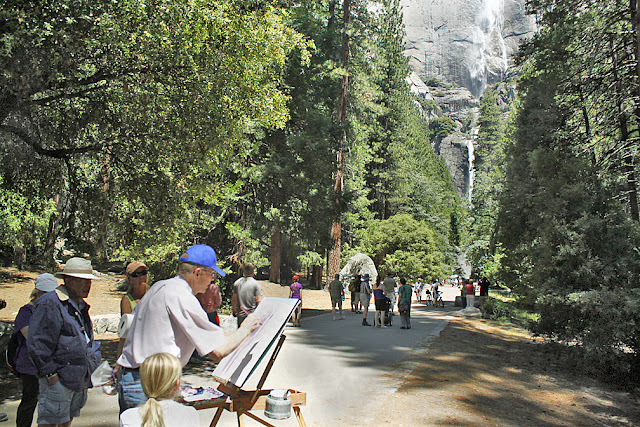Behind the Museum is The Indian Village of Ahwahnee which is a recreation of an Indian settlement in the Yosemite Valley, we left the museum through the back door and found ourselves in the village. A nice welcome sign greeted us at the beginning of the trail.
Among the
many exhibits we saw the Sweat house which is heated by an oak-wood fire. The
deer hunters would spend up to three hours inside then emerge and bath themselves.
Then, they rubbed themselves with wormwood or another aromatic plant to
remove human scent and allow the hunters to get closer to their quarry.
This
particular sweat house replaced several earlier sweat houses that stood on this
site and was built on a framework of four incense cedar poles covered with
successive layers of buchbrush.
Next
exhibit was the Miwok Cabin depicting the way Miwok people used to live. We
learned from the posted information that Miwok cabin came to existence soon
after non-Indian came to Yosemite in 1850’s and settle there. The local Indian people begun
to emulate the building style of these settlers and that’s how these cabins
came to existence.
Next
exhibit was the Chief’s House, and reading the information we learned that
Miwok leaders had large homes than others in the village, for they often hosted
dinners and events for large groups of people and by the turn of the century
many Miwok people built structures like this one: they were based on Miwok
homes, but built using Euro-American technology.
Next we saw a re-created Umatchas which was considered a typical Miwok and Paiute early home and was made from cedar bark. It gave us a taste of how the Miwok and Paiute peoples lived; the places where they prepared and cooked their food, and more.
Another
exhibit in the village was the Acorn Granary which used to store Black oak
acorns. The granaries were raised above the ground on stumps and consisted of a
nest-like containers made from grapevines and buck brush. The cavity was lined
with wormwood and then filled with acorns. The entire granary was then shingled
with conifer boughs and capped at the top with layers of more boughs, cedar
bark, and after the coming of non-Indians, canvas.















































